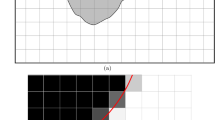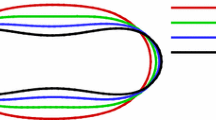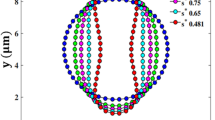Abstract
In this study, a reduced-order model for a deformable particle is introduced and implemented in the framework of discrete element method (DEM) with the application in biological cells such as red blood cell (RBC). In this model, a single deformable particle comprises a clump of rigid constituent spheres whose centroids are interconnected utilizing mathematical elastic bonds. To preserve the deformability, the bond model is calibrated for the static and dynamic behaviour of an RBC by using the experimental data from the literature. Good accuracy is observed in reproducing the mechanical response of various types of RBCs under different static loadings. For the dynamic calibration, the viscoelastic behaviour and the time-dependent deformation of the RBC are investigated and exhibit a good agreement with the literature. Then, the model is coupled with the immersed boundary method to evaluate the flow characteristics of a single RBC in blood plasma. The results reveal a consistent trend in predicting the drag force on the RBC with the previous investigations. This coupled model can be used in the resolved CFD–DEM simulation of biological flows in microfluidics.






Similar content being viewed by others
References
Fahraeus R, Lindqvist T (1931) The viscosity of blood in narrow capillary tubes. Am J Physiol 96:562–568
Sergé G, Silberberg A (1961) Radial particle displacements in Poiseuille flow of suspensions. Nature 189:209–210
Sergé G, Silberberg A (1962) Behavior of macroscopic rigid spheres in poiseuille flow. Part 1. Determination of local concentration by statistical analysis of particle passages through crossed light beams. J Fluid Mech 14:115–135
Sergé G, Silberberg A (1962) Behavior of macroscopic rigid spheres in poiseuille flow. Part 2. Experimental results and interpretation. J Fluid Mech 14:136–157
Goldsmith HL (1971) Deformation of human red blood cell in tube flow. Biorheology 7:235–242
Pozrikidis (2003) Numerical simulation of the flow-induced deformation of red blood cells. Ann Biomed Eng 31:1194–1205
Dao M, Lim CT, Suresh S (2003) Mechanics of the human red blood cell deformed by optical tweezers. J Mech Phys Solids 51:2259–2280
Bagchi P (2007) Mesoscale simulation of blood flow in small vessels. Biophys J 92:1858–1877
Chee CY, Lee HP, Lu C (2008) Using 3D fluid-structure interaction model to analyse the biomechanical properties of erythrocyte. Phys Lett A 372:1357–1362
Pivkin IV, Karniadakis GE (2008) Accurate coarse-grained modeling of red blood cells. Phys Rev Lett 101:118105
Fedosov DA, Caswell B, George EK (2010) A multiscale red blood cell model with accurate mechanics, rheology and dynamics. Biophys J 98:2215–2225
Nakamura M, Bessho S, Wada S (2012) Spring-network-based model of a red blood cell for simulating mesoscopic blood flow. Int J Numer Methods Biomed Eng 1:15–30
Li X, Vlahovska PM, Karniadakis GE (2013) Continuum- and particle-based modeling of shapes and dynamics of red blood cells in health and disease. Soft Matter 7:28–37
Ye T, Phan-Thien N, Lim CT (2016) Particle-based simulations of red blood cells—a review. J Biomech 49:2255–2266
Yoon D, You D (2016) Continuum modeling of deformation and aggregation of red blood cells. J Biomech 49:2267–2279
Závodszky G, van Rooij B, Aziz V, Hoekstra A (2017) Cellular level in-silico modeling of blood rheology with an improved material model for red blood cells. Front Physiol 8:563
Soleimani M, Sahraee S, Wriggers P (2019) Red blood cell simulation using a coupled shell-fluid analysis purely based on the SPH method. Biomech Model Mechanobiol 18:347–359
Lu H, Peng Z (2019) Boundary integral simulations of a red blood cell squeezing through a submicron slit under prescribed inlet and outlet pressure. Phys Fluids 31:0319002
Liu Y, Zhang L, Wang X, Liu WK (2004) Coupling of Navier–Stokes equations with protein molecular dynamics and its application to hemodynamics. Int J Numer Methods Fluids 46:1237–1252
Cimrak I, Gusenbauer M, Schrefl T (2012) Modelling and simulation of processes in microfluidic devices for biomedical applications. Comput Math Appl 64:278–288
Dupin MM, Halliday I, Care CM, Alboul L, Munn LL (2007) Modeling the flow of dense suspensions of deformable particles in three dimensions. Pyhs Rev E 75:066707-1–17
Kostalos C, Latt J, Chopard B (2019) Bridging the computational gap between mesoscopic and continuum modeling of red blood cells for fully resolved blood flow. arXiv:1903.06479
Pan W, Caswell B, Karniadakis GE (2010) A low-dimensional model for the red blood cells. Soft Matter 6:4366–4376
Pan W, Fedosov DA, Caswell B, Karniadakis GE (2011) Predicitng dynamics and rheology of blood flow: a comparative study of multiscale and low-dimensional models of red blood cells. Microvasc Res 82(2):163–170
Gidaspow D, Huang J (2009) Kinetic theory based model for blood flow and its viscosity. Ann Biomed Eng 37:1534–1545
Hager A, Kloss C, Pirker S, Goniva C (2014) Parallel resolved open source CFD–DEM: method, validation and application. J Comput Multiph Flows 6:13–27
Guo Y, Curtis J, Wassgren C, Ketterhagen W, Hancock B (2013) Granular shear flows of flexible rod-like particles. AIP Conf Proc 1542:491–494
Guo Y, Wassgren C, Hancock B, Ketterhagen W, Curtis J (2015) Computational study of granular shear flows of dry flexible fibers using the discrete element method. J Fluid Mech 775:24–52
Glowinski R, Pan TW, Hesla TI, Joseph DD, Périaux J (2001) A fictitious domain approach to the direct numerical simulation of incompressible viscous flow past moving rigid bodies: application to particulate flow. J Comput Phys 169:363–426
Mittal R, Iaccarino G (2005) Immersed boundary methods. Annu Rev Fluid Mech 37:239–261
Shirgaonkar AA, Maclver MA, Patnakar NA (2009) A new mathematical formulation and fast algorithm for fully resolved simulation of self-propulsion. J Comput Phys 228:2366–2390
Potyondy DO, Cundall PA (2004) A bonded-particle model for rock. Int J Rock Mech Min Sci 41:1329–1364
Fischer TM (2007) Tank-tread frequency of the red cell membrane: dependence on the viscosity of the suspending medium. Biophys J 93:2553–2561
Zhang J, Johnson PC, Popel AS (2008) Red blood cell aggregation and dissociation in shear flows simulated by lattice Boltzmann method. J Biomech 41:47–55
Fedosov DA, Noguchi H, Gompper G (2014) Multiscale modeling of blood flow: from single cells to blood rheology. Biomech Model Mechanobiol 13:239–258
Cordasco D, Bagchi P (2017) On the shape memory of red blood cells. Phys Fluids 29:041901
Yazdani AZK, Murthy Kalluri R, Bagchi P (2011) Tank-treading and tumbling frequencies of capsules and red blood cells. Phy Rev E 83:046305
Krüger T, Gross M, Raabe D, Varnik F (2013) Crossover from tumbling to tank-treading-like motion in dense simulated suspension of red blood cells. Soft Matter 9:9008–9015
Krüger T (2016) Effect of tube diameter and capillary number on platelet margination and near-wall dynamics. Rheol Acta 55:511–526
Kloss C, Goniva C, Hager A, Amberger S, Pirker S (2012) Models, algorithms and validation of opensource DEM and CFD–DEM. Prog Comput Fluid Dyn Int J 12(2/3):140–152
Suresh S, Spatz J, Mills JP, Micoulet A, Dao M, Lim CT, Beil M, Seufferlein T (2005) Connections between single-cell biomechanics and human disease states: gastrointestinal cancer and malaria. Acta Biomater 1:15–30
Skalak R, Torezen A, Zarda RP, Chien S (1973) Strain energy function of red blood cell membranes. Biophys J 13:245–264
Hochmuth RM, Worthy PR, Evans EA (1979) Red cell extensional recovery and the determination of membrane viscosity. Biophys J 26(1):101–114
Puig-de-Morales-Marinkovic M, Turner KT, Butler JP, Fredberg JJ, Suresh S (2007) Viscoelasticity of the human red blood cell. Am J Physiol Cell Physiol 293(2):C597–605
Gironella Torrent M, Ritort F (2016) Viscoelastic properties of red blood cells in a flow. In: Proceedings of international conference on statistical physics, p 389
Maria MS, Rakesh PE, Chandra TS, Sen AK (2016) Capillary flow of blood in a microchannel with differential wetting for blood plasma separation and on-chip glucose detection. Biomicrofluidics 10(5):054108
Acknowledgements
The authors acknowledge the financial support from STRATEC Consumable GmbH in Austria.
Author information
Authors and Affiliations
Corresponding author
Ethics declarations
Conflict of Interest
The authors declare that they have no conflict of interest.
Additional information
Publisher's Note
Springer Nature remains neutral with regard to jurisdictional claims in published maps and institutional affiliations.
Rights and permissions
About this article
Cite this article
Balachandran Nair, A.N., Pirker, S., Umundum, T. et al. A reduced-order model for deformable particles with application in bio-microfluidics. Comp. Part. Mech. 7, 593–601 (2020). https://doi.org/10.1007/s40571-019-00283-8
Received:
Revised:
Accepted:
Published:
Issue Date:
DOI: https://doi.org/10.1007/s40571-019-00283-8




